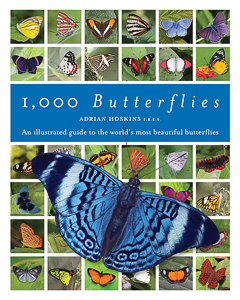 |
by Adrian Hoskins F.R.E.S.
From the publisher: Following on from his previous book, "Butterflies of the World" (Reed New Holland), Adrian Hoskins' new book "1,000 Butterflies: An illustrated guide to the world's most beautiful butterflies" showcases over 1000 species of the world's most beautiful and diverse butterflies.
It is estimated that the total number of scientifically described butterflies, including skippers and hedylids, is about 18,184 species. Those chosen for inclusion here are the ones most likely to be encountered by the average person, either because they are conspicuously coloured, or because they are particularly common in the part of the world where they occur.
1,000 Butterflies is devoted to the six 'traditional' butterfly families, but also includes the recently accepted Hedylidae. The families and their respective subfamilies, tribes, genera and species are arranged alphabetically for ease of reference. Including monarchs, birdwings, swordtails, morphos, glasswings and many more, 1000 Butterflies includes photographs of wild butterflies in their natural surroundings, accompanied by useful text on identification, interesting features and geographic distribution. This book also includes the latest updated taxonomy.
This book is marketed as a companion to Hoskins' recent Butterflies of the World (reviewed here). In some ways this is an accurate description but each work is stand-alone and the two are perhaps better regarded as alternative takes on the same basic theme - a comprehensive survey of the world's butterfly families - rather than as strictly complementary volumes. Either could be bought and enjoyed without any implicit obligation to buy the other.
The present work focuses on enumerating and illustrating genera and species, omitting the in-depth biological introduction of the previous book. To this end, the author has selected some 1,000 butterflies, covering the full range of diversity to be found in the group. Since this represents little more than 5% of the 18,000 or so butterfly species currently recognised, the book is in no way an identification guide. In addition, as the vast majority are illustrated with photos by the author - a quite remarkable feat, it might be noted - there is an inevitable de facto bias in the species chosen. All twelve of the Argynnine fritillaries shown, for example, are Old World, despite the fact the group is well represented in North America. To be fair, this does not make a lot of difference, as the New World fritillaries are broadly similar to the Old World ones, but an American might wonder why the strikingly different Speyeria diana gets only a mention and no picture.
 |  |
 |  |
Such quibbles aside - and this is a very minor quibble - the illustrations themselves are superb. There is a small overlap with those of the previous book, again doubtless reflecting the author's decision to contribute almost all the pictures himself, but this is not significant. Page after page of wonderful photographs, all taken in natural surroundings, bring the (adult) butterfly world to life in a way I think is unique among comparable books. In fact, the previous volume aside, I do not think there is a comparable book. All the other single-volume guides to the world's butterflies rely heavily or exclusively on set specimens.
The book is systematically and consistently organised. Each family is introduced with a brief description, after which the subfamilies and tribes are dealt with one by one. A useful (or geeky, depending on how you look at it) feature is the listing of all genera within each tribe, or within each subfamily where this does not have separate tribes assigned. Any such listing, however comprehensive, is inevitably provisional, as biological nomenclature undergoes constant revision, but I love it. In particular, it enables one to place any species in the context of the whole, whether or not it is mentioned or illustrated in its own right.
 |  |
 |  |
A useful glossary and comprehensive index conclude the book.
In a sense, this is a coffee table book - eminently browsable and gorgeously illustrated. At the price, it is worth getting for this alone. But because of its systematic completeness and impeccable research it is a serious addition to any butterfly library too. I wrote of the previous volume that it was difficult to find an argument not to buy it and the same holds true of this work, taken on its own. Should you buy both? I think they are sufficiently different to be able to recommend this but equally, as already suggested, each on its own gives a very good overview of the butterfly world.
As a kind of postscript, it would be nice if someone were to produce the same kind of book illustrating the fantastic range of early stages of butterflies. With Hoskins 1 and 2 in print, I feel there is no further need of any single-volume work on the adult butterflies of the world. Will there be a Hoskins 3 covering eggs, caterpillars and pupae? I hope so.
The books is available through all good book stores, including those that are online.